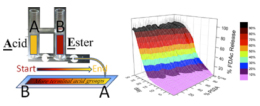ポリエステル薄膜における薬物放出の調節:添加剤を用いずに制御された薬物放出では末端基によって放出速度が決まる
Tuning drug release in polyester thin films: terminal end-groups determine specific rates of additive-free controlled drug release
2013年4月19日 NPG Asia Materials 5, e4 (2013) doi:10.1038/am.2013.9
生分解性ポリマー:薬物放出を微調整する

乳酸・グリコール酸共重合体(PLGA)などの生分解性・生体適合性ポリエステルは、薬物送達に適している。このようなポリエステル材料の薄膜や小粒子には、小分子からワクチンに至るまでさまざまな薬物を閉じ込めることができ、ポリエステルが体内で分解されると薬物が放出されるのである。薬物の放出速度の制御は通常、ポリエステルマトリックスにポリエチレングリコールなどの添加剤を導入することによって行われるが、添加剤の導入は、ポリエステル材料の機械的性質や膨潤性などの特性にも影響を及ぼしてしまう。こうした問題を回避するため、南洋理工大学(シンガポール)のTerry Steele、Joachim LooおよびSubbu Venkatramanを中心とする研究チームはこれまで、添加剤の代わりにポリエステルの分子量と末端官能基を利用する方法を研究してきた。そして今回、一部の標準的なエステル基を溶けやすいカルボン酸基に置き換えてPLGAの末端基を少し変えることにより、材料の分解、ひいてはポリエステル薄膜からの薬物分子の放出が大きく左右されることを明らかにした。
Biodegradable polymers: Drug release fine-tuned
Biodegradable, biocompatible polyesters such as polyester poly(lactic-co-glycolic acid) (PLGA) are well suited to drug delivery: species ranging from small molecules to vaccines can be trapped within thin films or small particles of the material, and released on its degradation in the body. Control of the release rate is commonly achieved by incorporating additives to the polyester matrix, for example polyethylene glycol. However, this also affects other characteristics, such as the material's mechanical or swelling properties. To circumvent this issue, Terry Steele, Joachim Loo, Subbu Venkatraman and co-workers from Nanyang Technological University in Singapore have explored how the polyester's molecular weight and terminal functional groups could be used instead. Small variations in the PLGA terminal groups — replacing some of the standard ester group for more soluble carboxylic acid moieties — proved to have a significant effect on the material's degradation, and thus the release of drug molecules from thin films.

